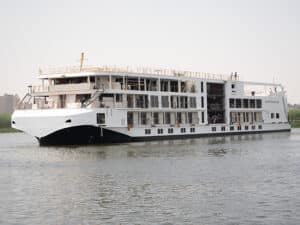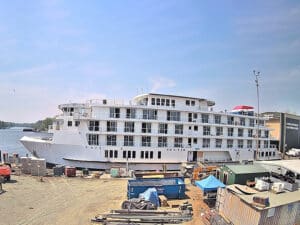
FMC Commissioner Sola: Canceled cruise season hitting Alaska hard
Written by Nick Blenkey
Federal Maritime Commissioner Louis E. Sola : “I hope to never see another no sail or conditional sail order issued.”
Considered on a per capita basis, there may not be another state in the nation paying as high a cost from passenger ships not sailing as Alaska. That is one of the findings in an interim report by Federal Maritime Commissioner Louis Sola as part of the FMC’s Fact Finding 30 investigation, “COVID-19 Impact on Cruise Industry.”
The interim report examines 16 Alaskan ports as well as ports in Seattle and Astoria, Ore.
“It is important to this Fact Finding to visit the cities and regions where cruising is part of the economy, hear from those affected, and report on the consequences of vessels not operating,” said Sola.”While tourism benefits all our Northwestern states, it is one of three pillars of the Alaskan economy. Passenger cruising is a vital part of the Alaskan tourism business and the loss of an entire cruise season has led to the loss of revenue for a disproportionate number of Alaskans.
Alaska’s economy rests on three key industries: energy, fishing, and tourism. The last category has been a growth industry for the state, with the number of visitors increasing 45% from 1.5 million in 2010 to 2.2 million in 2019. Cruising is an important part of the tourism sector, in 2019, 1.3 million people traveled on cruise ships.
“In 2019, twice as many people than the number who live in the state came to Alaska and took a cruise. With the suspension of the cruise season, the economic activity of 1.3 million visitors was wiped out of the Alaskan economy for the year. Under the best of circumstances and in any other state, there would be no disguising the consequences of losing that much revenue. In Alaska, in the context of the cruise industry, the consequences are greatly exacerbated,” said Sola.
Some Alaskan port facilities and terminals exist solely to support passenger vessels. There is a segment of the hotel sector that specializes in serving cruise vessels, building lodging facilities only accessible to passenger vessels. Like other locations in the United States, cruise passengers spend on a variety of activities such as dining, lodging, transportation, and shopping that support the local economy and infrastructure. The difference between Alaska and other states is that in many locations, the cruise industry may be the only economic driver.
Another economic consequence of the loss of the 2020 Alaska cruise season is the missed direct contribution the cruise companies make to the state. In addition to providing services to tourists, cruise companies operating in Alaska base thousands of crew members in the state who pay rent, shop in grocery stores, eat in restaurants, and purchase services. Furthermore, cruise lines and their subsidiaries, spend close to $300 million in procuring goods and services from Alaska-based companies.
“If a ship does not call, especially at some of the smaller cruise focused ports in Alaska, people do not make money,” said Sola. “If there is no cruise ship in port, there is no work for the longshoremen. If there is no cruise ship in port, no one is shopping in local businesses or eating in local restaurants. If there is no cruise ship in port, landside tour companies have no clients. In major metropolitan areas with major seaports, there will more likely be other opportunities for people to pursue while they wait for cruise ships to begin operating again. In many places in Alaska, the cruise business is the local industry. These are cities of hundreds, or a few thousand, residents. The people, businesses, and ports in those locations are facing the unenviable challenge of what to do before next year’s cruise season.”
The economic impact to municipalities and the state is also significant, and not only because of the loss of tax revenues to the general fund. Cruise ships operating in Alaska waters, and passengers aboard those vessels, are subject to a variety of fees that finance necessary cruise industry infrastructure as well as environmental conservation efforts that protect areas in which the ships operate. The Commercial Vessel Passenger Tax, the Commercial Passenger Vessel Environmental Compliance Program, and the Ocean Ranger Program, all rely on fee payments tied directly to cruise companies and cruise passengers.
Alaska is served by more than just the major cruise lines. Smaller operators that are U.S.-based companies or who sail U.S. flagged ships also serve the market.
The nature of the Alaska cruise industry ties that state to Washington and Oregon. The Port of Seattle is the homeport for many cruise ships and more than one million individuals fly in and out of the Seattle-Tacoma International Airport to take cruise voyages. The hotel, ground transportation, and tourism sectors have all been affected by the cessation of cruise operations in general and the suspension of the Alaska season in particular. Similarly, the Port of Astoria, Oregon has weathered an economic impact as a result of lost cruise business.
“The Alaska cruise season is short, lasting approximately only five months. While the 2020 season is lost, there is hope for the 2021 season,” said Sola. “Companies and port authorities are focused on the steps necessary to safely return to full operations and to provide cruise customers with the assurances necessary to be confident again boarding a vessel. Better than most, the men and women who are government officials, port executives, and tourism leaders know what is at stake and are doing what they must to limit their losses and welcome back cruise passengers.”
Download the full interim report HERE.



